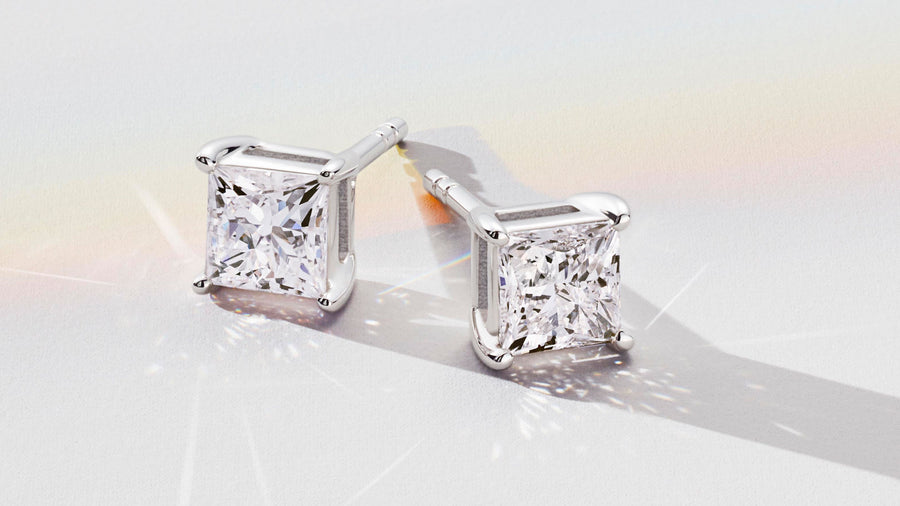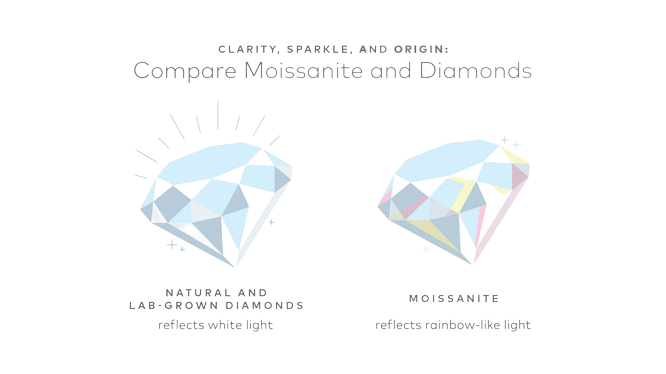It’s only natural that as a lab-grown diamond company, we’re often compared to other lab-grown stones. At first glance, moissanite is often confused with diamonds, thanks in large part to the stone’s clear coloring and glittering finish. On the surface, they may look similar, but dig into the chemical makeup of the stone and you’ll see that moissanite and lab-grown diamonds or natural diamonds are vastly different. Sure, moissanite has its own unique price-conscious appeal. But, if you’re wondering if moissanite is the best stone for your lifestyle and jewelry box, it’s important to consider key differences in color, brilliance, and durability. Here we add clarity and context to those curious about the difference between moissanite and natural or lab-grown diamonds.

What is Moissanite?
Moissanite is a naturally occurring, gem-quality mineral called silicon carbide (SiC) or carborundum. Moissanite was discovered by a Nobel Prize-winning French chemist named Henri Moissan in 1893. Moissan thought he had hit the proverbial jackpot while he was inspecting rocks in a crater caused by a meteor in Arizona. Originally, Moissan thought what he found were diamonds but after years of studying the natural matter, he realized it was silicon carbide. It would take nearly a century after Moissan’s discovery for scientists to figure out how to transform the silicon carbide into jewelry-ready stones in a lab. Today, all moissanite is made in a lab. In fact, because naturally occurring moissanite is so uncommon, there’s not enough on earth to make a single pair of earrings.

Moissanite vs. Diamonds
Is moissanite a diamond? No. There are technical details we’ll get into in a bit, but here’s the bird’s-eye view: Lab-grown diamonds are chemically and structurally identical to natural diamonds, and moissanite is engineered to be a diamond imitation. While both moissanite and Lightbox lab-grown diamonds are created in a lab, key differences include the laboratory process used to make them, their durability, and the color of the stones. But, most importantly, moissanite is simply not a diamond nor is it as valuable.
Moissanite vs. Diamond side by side
When shopping for a piece of jewelry that uses moissanite, customers often note the lower price point compared to natural or lab-grown diamonds, the stone’s durability, and the sparkle (sometimes referred to as “fire”) of the gemstone. But, can you tell the difference between moissanite and a diamond using your naked eye? The answer is, absolutely yes. Here’s what you need to know about the difference between moissanite and diamond.
The Prism Effect
One of the easiest ways to tell the difference between moissanite and diamond is to evaluate the jewelry in bright light. Diamonds hold white light, giving the stone a brilliant scintillation while moissanite has more of a rainbow dispersion effect. A telltale sign that you’re looking at moissanite is seeing a rainbow prism when the stone catches the light. Moissanite turns more white light into colored light, known as a prismatic or “disco-ball” effect. The larger the moissanite, the more detectable the rainbow refraction will be. In Lightbox’s lab-grown diamonds, the color of our white diamonds is near colorless which will result in a beautiful sparkle.
The Gemological Institute of America, known as GIA and the world’s foremost authority on diamonds and colored stones, says that moissanite’s intense fire will “give it away as a non-diamond gem”.
At the end of the day, there are optical and structural differences, but Lightbox’s lab-grown diamonds are grown to incredibly high standards and their improved durability (more on that below) over moissanite, makes them, in our opinion, the superior option.
Both moissanite and lab-grown diamonds are available in several color choices. Lightbox’s lab-grown diamonds come in brilliant white, pink, and blue. In addition to white, moissanite comes in yellow, blue, and black.
Moissanite vs. Diamond Stone Strength
A stone’s strength is ranked zero to ten on the Mohs Hardness Scale. Diamonds, including lab-grown diamonds, are one of the most durable materials on the planet and rank a perfect ten. While not nearly as tough or as durable as a natural or lab-grown diamond, moissanite has a hardness of 9.25, which means it can typically incur daily wear and tear.
Moissanite vs. Diamond Brilliance
Brilliance is what gives diamonds their wow factor, their sparkle, and it comes from how a stone reflects light. Diamonds have a high refractive index but moissanite has double refraction, meaning the back of the stone’s facets reflects twice. To the naked eye, the inside of moissanite may appear blurry, slightly yellow, or gray. To an armchair expert, the visual difference between the two stone types is clear, and once you see it, it’s hard to unsee the optical comparison.
Moissanite vs. Diamond Pricing
Moissanite is a cheaper material than natural or lab-grown diamond and is therefore normally available at a lower retail price. However, like natural and lab-grown diamonds, the price of moissanite depends on the color quality of the stone. Moissanites are typically offered in colorless and near-colorless options, which, if you’re looking at a natural or lab-grown diamond, covers D, E, F for colorless and G, H, I for near-colorless. Every Lightbox lab-grown diamond has a cut grade of at least very good, which is the second-highest grading a diamond, both natural and lab-grown, can achieve.
Lightbox’s lab-grown diamonds cost 800 USD a carat (or 1500 USD a carat for our Lightbox Finest™ stones). Because our lab experts can precisely replicate our high-quality standards with each diamond produced, our pricing is transparent and based on carat weight alone. When you purchase a natural diamond, the price fluctuates significantly based on a number of factors, like size, quality of color and clarity, and the type of cut. The sum of those factors makes it difficult to estimate price, as it’s based on rarity.
There’s no question that we all want a little sparkle, but for us the enduring, stronger, and brighter natural or lab-grown diamond is the go-to choice for value and quality.

